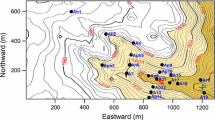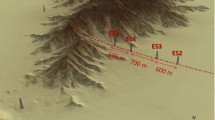Abstract
An investigation into high Reynolds number turbulent flow over a ridge top in New Zealand is described based on high-resolution in-situ measurements, using ultrasonic anemometers for two separate locations on the same ridge with differing upwind terrain complexity. Twelve 5-h periods during neutrally stratified and weakly stable atmospheric conditions with strong wind speeds were sampled at 20 Hz. Large (and small) turbulent length scales were recorded for both vertical and longitudinal velocity components in the range of 7–23 m (0.7–3.3 m) for the vertical direction and 628–1111 m (10.5–14.5 m) for the longitudinal direction. Large-scale eddy sizes scaled to the WRF (Weather Research and Forecasting) numerical model simulated boundary-layer thickness for both sites, while small-scale turbulent features were a function of the complexity of the upwind terrain. Evidence of a multi-scale turbulent structure was obtained at the more complex terrain site, while an assessment of the three-dimensional isotropy assumption in the inertial subrange of the spectrum showed anisotropic turbulence at the less complex site and evidence of isotropic turbulence at the more complex site, with a spectral ratio convergence deviating from the 4/3 or unity values suggested by previous theory and practice. Existing neutral spectral models can represent locations along the ridge top with simple upwind complexity, especially for the vertical wind spectra, but sites with more orographic complexity and strong vertical wind speeds are often poorly represented using these models. Measured spectra for the two sites exhibited no significant diurnal variation and very similar large-scale and small-scale turbulent length scales for each site, but the turbulence energy measured by the variances revealed a strong diurnal difference.
Similar content being viewed by others
References
Batchelor GK (1986) The theory of homogeneous turbulence. Cambridge University Press, Cambridge, 197 pp
Biltoft CA (2001) Some thoughts on local isotropy and the 4/3 lateral to longitudinal velocity spectrum ratio. Boundary-Layer Meteorol 100: 393–404
Bougeault P, Binder P, Buzzi A, Dirks R, Houze R, Kuettner J, Smith RB, Steinacker R, Volkert H (2001) The MAP special observing period. Bull Am Meteorol Soc 82: 433–462
Bradley EF (1980) An experimental study of the profiles of wind speed, shearing stress and turbulence at the crest of a large hill. Q J Roy Meteorol Soc 106: 101–123
Britter RE, Hunt JCR, Richards JK (1981) Air flow over a two-dimensional hill. Studies of velocity speed-up, roughness effects and turbulence. Q J Roy Meteorol Soc 107: 91–110
Burton T, Sharpe D, Jenkins N, Bossanyi E (2001) Wind energy handbook. Wiley, West Sussex, 617 pp
Cao S, Tamura Y, Kikuchi N, Saito M, Nakayama I, Matsuzaki Y (2009) Wind characteristics of a strong typhoon. J Wind Eng Ind Aerodyn 97: 11–21
Chamecki M, Dias NL (2004) The local isotropy hypothesis and the turbulent kinetic energy dissipation rate in the atmospheric surface layer. Q J Roy Meteorol Soc 130: 2733–2752
Counihan J (1975) Adiabatic atmospheric boundary layers, a review and analysis of data from the period 1880–1972. Atmos Environ 9: 871–905
De Franceschi M (2004) Investigation of atmospheric boundary layer dynamics in alpine valleys. Dissertation, University of Trento
Frisch U (1995) Turbulence, the legacy of A.N. Kolmogorov. Cambridge University Press, Cambridge, p 296
Hogstrom U, Hunt JCR, Smedman AS (2002) Theory and measurements for turbulence spectra and variances in the atmospheric neutral surface layer. Boundary-Layer Meteorol 103: 101–124
Huaxing LU (ed) (2008) Modelling terrain complexity. In: Advances in digital terrain analysis. Springer, Berlin, pp 159–176
Hunt JCR, Morrison JF (2000) Eddy structure in turbulent boundary layers. Eur J Mech B Fluids 19: 673–694
Jackson PS, Hunt JCR (1975) Turbulent wind flow over a low hill. Q J Roy Meteorol Soc 101: 929–955
Janjic ZI (1990) The step-mountain coordinate: physical package. Mon Weather Rev 118: 1429–1443
Jiboori MH, Yumao X, Yongfu Q (2001) Turbulence characteristics over complex terrain in west China. Boundary-Layer Meteorol 101: 109–126
Kaimal JC, Finnigan JJ (1994) Atmospheric boundary layer flows. Their structure and measurement. Oxford University Press, Oxford, p 289
Kaimal JC, Wyngaard JC, Izumi Y, Cote OR (1972) Spectral characteristics of surface layer turbulence. Q J Roy Meteorol Soc 98: 563–589
Kaimal JC, Wyngaard JC, Haugen DA, Cote OR, Izumi Y, Caughey SJ et al (1976) Turbulence structure in the convective boundary layer. J Atmos Sci 33: 2152–2169
Kolmogorov AN (1941a) The local structure of turbulence in incompressible viscous fluid for very large Reynolds number. Dokl Akad Nauk SSSR 30: 299–303
Kolmogorov AN (1941b) Energy dissipation in locally isotropic turbulence. Q J Roy Meteorol Soc 32: 19–21
Li W, Hiyama T, Kobayashi N (2007) Turbulence spectra in the near-neutral surface layer over the Loess plateau in China. Boundary-Layer Meteorol 124: 449–463
Lumley J, Yaglom A (2001) A century of turbulence. Flow Turbul Combust 66: 241–286
Martins C, Moraes O, Acevedo O, Degrazia G (2009) Turbulence intensity parameters over a very complex terrain. Boundary-Layer Meteorology 133: 35–45
McNaughton KG, Brunet Y (2002) Townsend’s hypothesis, coherent structures and Monin-Obukhov similarity. Boundary-Layer Meteorol 102: 161–175
Mellor GL, Yamada T (1982) Development of a turbulence closure model for geophysical fluid problems. Rev Geophys Space Phys 20: 851–875
Mickle R, Cook N, Hoff A, Jensen N, Salmon J, Taylor P et al (1988) The Askervein Hill project. Vertical profiles of wind and turbulence. Boundary-Layer Meteorol 43: 143–169
Moraes O, Acevedo O, Degrazia G, Anfossi D, da Silva R, Anabor V (2005) Surface layer turbulence parameters over a complex terrain. Atmos Environ 39: 3103–3112
Obukhov AM (1941) On the energy distribution in the spectrum of a turbulent flow. Ser Geogr Geofiz 5: 453–466
Panofsky HA, Larko D, Lipschutz R, Stone G (1982) Spectra of velocity components over complex terrain. Q J Roy Meteorol Soc 108: 215–230
Rotach MW, Zardi D (2007) On the boundary layer structure over highly complex terrain: key findings from MAP. Q J Roy Meteorol Soc 133: 937–948
Skamarock WC, Klemp JB, Dudhia J, Gill DO, Barker DM, Duda MG, Huang X, Wang W, Powers JG (2008) A description of the Advanced Research WRF version 3. NCAR technical note. http://www.mmm.ucar.edu/wrf/users/docs/user_guide_V3.1/contents.html. Accessed 18 Dec 2009
Sturman A, Tapper N (2006) The weather and climate of Australia and New Zealand, 2nd ed. Oxford University press, Oxford, 541 pp
Teunissen HW (1980) Structure of mean wind and turbulence in the planetary boundary layer over rural terrain. Boundary-Layer Meteorol 19: 187–221
Townsend AA (1961) Equilibrium layers and wall turbulence. J Fluid Mech 11: 97–120
Townsend AA (1972) Flow in a deep turbulent boundary layer over a surface distorted by water waves. J Fluid Mech 55: 719–735
Tsvang LR (1985) Atmospheric turbulence research at the Tsimlyansk Scientific Station of the Institute of the Physics of the Atmosphere of the USSR Academy of Sciences Izv. Atmos Ocean Phys 21: 261–267
Tsvang LR, Koprov BM, Zubkovskii SL, Dyer AJ, Hicks B, Miyake M, Stewart RW, McDonald JW (1973) A comparison of turbulence measurements by different instruments. Tsimlyansk field experiment 1970. Boundary-Layer Meteorol 3: 499–521
Tsvang LR, Kukharets VP, Perepelkin VG (1998) Atmospheric turbulence characteristics over a temperature-inhomogeneous land surface. Part II: The effect of small-scale inhomogeneities of surface temperature on some characteristics of the atmospheric surface layersurface layer. Boundary-Layer Meteorol 86: 103–124
Volkert H, Gutermann T (2007) Inter-domain cooperation for mesoscale atmospheric laboratories : The mesoscale alpine programme as a rich study case. Q J Roy Meteorol Soc 133: 949–967
Weigel AP (2005) On the atmospheric boundary layer over highly complex topography. Dissertation, ETH Zurich
Weigel AP, Rotach MW (2004) Flow structure and turbulence characteristics of the daytime atmosphere in a steep and narrow alpine valley. Q J Roy Meteorol Soc 130: 2605–2627
Weigel AP, Chow FK, Rotach MW (2007) On the nature of turbulent kinetic energy in a steep and narrow alpine valley. Boundary-Layer Meteorol 123: 177–199
Welch P (1967) The use of fast Fourier transform for the estimation of power spectra: A method based on time averaging over short, modified periodograms. IEEE Trans Audio Electroacoust 15: 70–73
Whiteman CD (2000) Mountain meteorology, fundamentals and applications. Oxford University Press, Oxford, 355 pp
Yaglom AM (1994) Fluctuation spectra and variances in convective turbulent boundary layers: a re-evaluation of old models. Phys Fluids 6: 962–972
Zeman O, Jensen NO (1987) Modification of turbulence characteristics in flow over hills. Q J Roy Meteorol Soc 113: 55–80
Author information
Authors and Affiliations
Corresponding author
Rights and permissions
About this article
Cite this article
Katurji, M., Sturman, A. & Zawar-Reza, P. An Investigation into Ridge-Top Turbulence Characteristics During Neutral and Weakly Stable Conditions: Velocity Spectra and Isotropy. Boundary-Layer Meteorol 139, 143–160 (2011). https://doi.org/10.1007/s10546-010-9576-y
Received:
Accepted:
Published:
Issue Date:
DOI: https://doi.org/10.1007/s10546-010-9576-y




